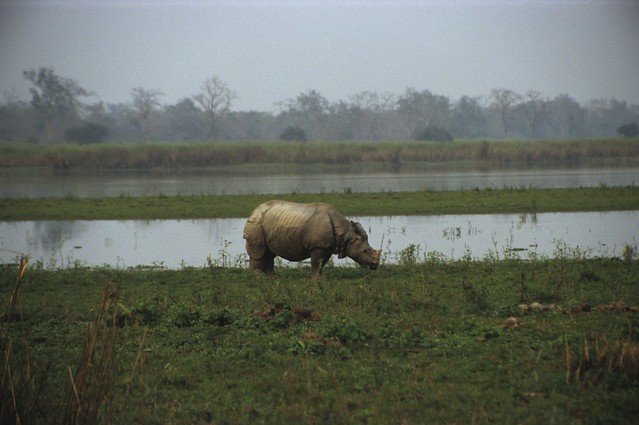Picture a schoolyard in spring. Toddlers are at play on iPhones, elementary school children skillfully jostle through the realm of Angry Birds, teenagers master coding homework on their laptops. To the keen (and not so keen) observer, the fight against new technology is a steep, uphill battle. More time in the digital world and less in the natural one is often viewed by environmentally-minded folks as a threatening prospect.
 Photo by gnozef/FlickrA one-horned rhino grazes in Kaziranga National Park, Assam, India. The study also reveals that the majority of at-risk species are disproportionately located in biologically-rich, “hot-spot” regions across the world. These hot-spots are also the most vulnerable to land-use and climate change impacts.
Photo by gnozef/FlickrA one-horned rhino grazes in Kaziranga National Park, Assam, India. The study also reveals that the majority of at-risk species are disproportionately located in biologically-rich, “hot-spot” regions across the world. These hot-spots are also the most vulnerable to land-use and climate change impacts.
But, what if new technologies are actually the secret weapon needed to combat biodiversity loss? A new Duke University study published today in the journal Science suggests that technology, contrary to popular concern, should play an increasingly important role in the campaign for species and habitat protection.
The current loss of unique species, according to the study, is 1,000 times higher than the natural rate of extinction. The study suggests that lack of adequate data — especially data on species yet unknown to science, their locations, and their rates of extinction — prevents an even more precise estimation. A more accurate rate, the authors predict, will be higher than the current calculation.
The study also reveals that the majority of at-risk species live in small ranges. These ranges, the authors find, are disproportionately located in biologically-rich, “hot-spot” regions. These “hot-spots” are also the most vulnerable to land-use and climate change impacts.
“Species with small ranges are disproportionately likely to go extinct. This knowledge offers the hope that we can concentrate our conservation efforts on critical places around the planet,” says Stuart L. Pimm, a professor of conservation ecology at Duke University and lead author of the study.
The protection of “hot-spot” regions, the authors suggest, may be the most effective strategy for species conservation. More comprehensive data is needed, however, to more accurately identify these critical locations. This is where new technology comes into play.
“Online databases, smartphone apps, crowd-sourcing and new hardware devices are making it easier to collect data on species,” says Pimm. “When combined with data on land-use change and the species observations of millions of amateur citizen scientists, technology is increasingly allowing scientists and policymakers to more closely monitor the planet’s biodiversity and threats to it.”
In order to develop more effective conservation policy in an age of complex and growing environmental threats, cross-country and inter-university data sharing is needed.
“The great depth of our current assessment is only possible thanks to the extraordinary efforts of all those who contribute to the databases of the Red List of Threatened Species and of Protected Planet,” says Tom Brooks of the International Union for Conservation of Nature. “We need to stimulate the investment essential to maintain these knowledge products, and to support the expansion of the Red List from its current coverage of 70,000 species to 160,000 species.” (The IUCN Red List is the world’s most comprehensive inventory of biological species and their conservation status.)
Although online databases, smartphone apps, crowd-sourcing, and new hardware devices are facilitating more efficient data and information sharing, the study finds that current technologies are inadequate for the task at hand. “For our success to continue, we need to support the expansion of these technologies and the development of even more powerful technologies to come,” says Pimm.
These findings suggest a recalibration of thought. Perhaps anti-technology activists should campaign for a shift in technology’s use and scope as opposed to its downscaling or elimination.
The modern schoolyard may be dotted with more Apple products than fruit but, one key childhood lesson is clearly not lost with the shifting times. Sharing is, indeed, caring. According to the new Duke University study, species data sharing is needed now more than ever. The golden ticket for more sophisticated and comprehensive conservation studies and policies, the authors suggest, could be the very iPhone, digital device or cool new app proliferating across the school playground.
We don’t have a paywall because, as a nonprofit publication, our mission is to inform, educate and inspire action to protect our living world. Which is why we rely on readers like you for support. If you believe in the work we do, please consider making a tax-deductible year-end donation to our Green Journalism Fund.
Donate